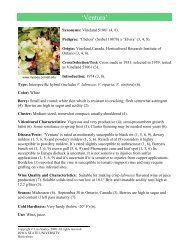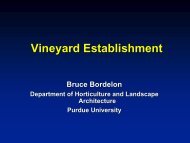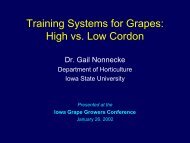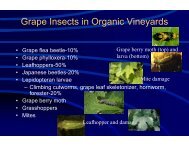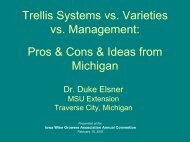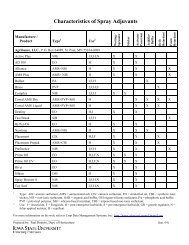Efficient Vineyard Fertilization and Plant Nutrition - Viticulture Iowa ...
Efficient Vineyard Fertilization and Plant Nutrition - Viticulture Iowa ...
Efficient Vineyard Fertilization and Plant Nutrition - Viticulture Iowa ...
You also want an ePaper? Increase the reach of your titles
YUMPU automatically turns print PDFs into web optimized ePapers that Google loves.
<strong>Efficient</strong> <strong>Vineyard</strong> <strong>Fertilization</strong><br />
<strong>and</strong> <strong>Plant</strong> <strong>Nutrition</strong><br />
Dr. Paul Domoto<br />
Dept. of Horticulture<br />
<strong>Iowa</strong> State University
<strong>Vineyard</strong> Management<br />
Vine<br />
Growth<br />
Fruit<br />
Production<br />
Maintaining a Balance<br />
Pruning<br />
<strong>Fertilization</strong>
Essential Mineral Nutrients<br />
Macro Elements:<br />
Nitrogen (N)<br />
Phosphorous (P)<br />
Potassium (K)<br />
Magnesium (Mg)<br />
Calcium (Ca)<br />
Sulfur<br />
(S)<br />
Micro Elements:<br />
Manganese (Mn)<br />
Iron<br />
(Fe)<br />
Boron<br />
(B)<br />
Copper (Cu)<br />
Zinc<br />
(Zn)<br />
Molybdenum (Mo)<br />
N, K <strong>and</strong> Zn are the nutrients that will<br />
most likely limit grape production in <strong>Iowa</strong>.
Availability of<br />
Essential Mineral Nutrients<br />
• Composition of the soil<br />
parent material.<br />
• Soil pH<br />
• Soil weathering / leaching<br />
• Soil organic matter content<br />
• Previous fertilizer history
Nutrient Availability<br />
as Influenced by Soil pH<br />
(Wider the bar, the greater the availability)
Determining the Need for Fertilizer<br />
• Visual:<br />
<strong>Plant</strong> vigor – A “shot in the dark”<br />
Should be adjusting pruning to plant vigor – practicing the “30<br />
Plus 10 Rule” to maintain a balance between vine growth <strong>and</strong><br />
fruiting.<br />
Deficiency symptoms – Generally too late<br />
• Soil testing:<br />
Suitable for pre-plant testing.<br />
Only good for of some nutrients.<br />
• Petiole Analysis:<br />
Reliable after first growing season.<br />
Measures what plants are able to take up.
Pre-plant Soil Test<br />
• Test for: pH, P, K, Zn, O.M.<br />
• Separate sample for each soil type.<br />
• Separate samples for different cropping<br />
histories.<br />
• Submit samples collected from 2 depths:<br />
0 to 6 or 8 inch depth.<br />
6 or 8 inch to 12 or 16 inch depth.<br />
• For samples sent to the ISU Soil Testing Lab.<br />
indicate on submission form that the results<br />
be sent to me for interpretation.
Desirable Soil Test Ranges for<br />
Grapes<br />
Test<br />
pH<br />
Organic matter<br />
Phosphorous (P)<br />
Potassium (K)<br />
Magnesium (Mg)<br />
Boron (B)<br />
Zinc (Zn)<br />
Bul. . 861*<br />
5.5 to 6.5<br />
2 to 3 %<br />
20 to 50 ppm<br />
125 to 150 ppm<br />
100 to 125 ppm<br />
.75 to 1.0 ppm<br />
4 to 5 ppm<br />
Corn /<br />
Soybeans<br />
- -<br />
- -<br />
30 ppm<br />
150 ppm<br />
- -<br />
- -<br />
> 1 ppm<br />
* Midwest Small Fruit Pest Management H<strong>and</strong>book
Soil vs Petiole Analysis<br />
Pre-plant:<br />
Soil<br />
• Adjust pH, bring P & K to<br />
optimum.<br />
• Not an accurate test for<br />
many nutrients.<br />
2nd year & beyond:<br />
• Monitor pH.<br />
• Basis for K rate if petiole<br />
analysis indicates a short<br />
supply.<br />
Petiole<br />
1st year:<br />
• Not accurate<br />
• Reflects growing conditions in<br />
the nursery.<br />
2nd year & beyond:<br />
• Accurate measure of most<br />
essential nutrients.<br />
• Sampling time is important.<br />
• Annual analysis allows for finetuning<br />
of the fertilizer program,<br />
& correcting shortages before<br />
they become a problem.
ISU Soil Testing Laboratory<br />
• Phone: (515) 294-3076<br />
• Web: http://www.agron.iastate.edu/soiltesting/<br />
• Publication: ST-11 “Soil sample information sheet for<br />
horticultural crops”<br />
http://www.extension.iastate.edu/Publications/ST11.pdf<br />
• Sampling kits <strong>and</strong> submission forms (ST-11)<br />
Available at County Extension offices
Commercial <strong>Plant</strong> Analysis Labs<br />
(Also do soil analysis)<br />
• A & L Laboratories Atlantic, IA Ph: 712-243-6933<br />
http://www.al-laboratories.com/lab-atlantic.htm<br />
• Belmond, Labs, Inc Belmond, IA Ph: 641-444-3384<br />
http://www.belmondlabs.com<br />
• Harris Laboratories Lincoln, NE Ph: 402-476-2811<br />
• Midwest Laboratories, Inc. Omaha, NE<br />
Ph: 402-334-7770<br />
http://www.midwestlabs.com<br />
• Minnesota Valley Testing Laboratories Nevada, IA<br />
Ph: 515-382-5486 or 800-362-0855<br />
http://mvtl.com
Normal Nutrient Ranges for Grapes<br />
Based on Petiole Analysis<br />
Macro Nutrient<br />
Nitrogen (N)<br />
Phosphorous (P)<br />
Potassium (K)<br />
Calcium (Ca)<br />
Magnesium (Mg)<br />
Sulfur (S)<br />
At<br />
Full Bloom<br />
1.6 to 2.8 %<br />
0.20 to 0.60 %<br />
1.50 to 5.00 %<br />
0.40 to 2.50 %<br />
0.13 to 0.40 %<br />
No data<br />
Mid-July /<br />
Mid-Aug.<br />
0.9 to 1.3 %<br />
0.16 to 0.29 %<br />
1.50 to 2.50 %<br />
1.20 to 1.80 %<br />
0.26 to 0.45 %<br />
No data<br />
The nutrient content changes during the season. Therefore,<br />
it is important to collect petiole samples at the proper time.
Normal Nutrient Ranges for Grapes<br />
Based on Petiole Analysis<br />
Micro Nutrient<br />
Manganese (Mn)<br />
Iron (Fe)<br />
Boron (B)<br />
Copper (Cu)<br />
Zinc (Zn)<br />
Molybdenum (Mo)<br />
At<br />
Full Bloom<br />
18 to 100 ppm<br />
40 to 180 ppm<br />
25 to 50 ppm<br />
5 to 10 ppm<br />
20 to 100 ppm<br />
0.2 to 0.4 ppm<br />
Mid-July /<br />
Mid-Aug.<br />
31 to 150 ppm<br />
31 to 50 ppm<br />
25 to 50 ppm<br />
5 to 15 ppm<br />
30 to 50 ppm<br />
0.3 to 1.5 ppm<br />
Sampling at full bloom is good for N. However, sampling<br />
from mid-July to mid-August is more reliable for all nutrients.
Nitrogen<br />
• Fertilizer<br />
• Legumes<br />
(Fix up to 300 lb / A / yr)<br />
• Soil organic matter<br />
(Releases<br />
~20 lb / A / % OM / yr)<br />
• Lightning<br />
Source<br />
(Fix ~10 lb / A / yr)<br />
Fate<br />
Lost from Soil:<br />
• Leaching<br />
• De-nitrification<br />
Taken up by <strong>Plant</strong>s:<br />
• Recycled:<br />
Leaves & Prunings<br />
• Removed: Fruit<br />
• Tied up: Old wood
How Much Nitrogen is Needed?<br />
Mid-Atlantic Wine Grapegrower’s<br />
Guide:<br />
• Grapes ~.18% N, Canes ~ .25% N<br />
• Nitrogen removed:<br />
Grapes: 3.6 lb / A / ton<br />
Canes: 1.7 lb / A / lb of prunings / vine<br />
• For a 3 ton crop & 2 lb prunings / vine:<br />
Grapes: 10.8 lb / A + prunings 3.4 lb / A
How Much Nitrogen is Needed?<br />
Cahoon. Grapes, Production, Management &<br />
Marketing. Ohio State Bul. 815:<br />
“Most vineyards should receive between 40 <strong>and</strong><br />
80 pounds of actual nitrogen per year.”<br />
• Sod occupies 2/3’s of the l<strong>and</strong> <strong>and</strong> requires ~ 1 lb N /<br />
1000 sq.ft. (~30 lb / A).<br />
• Grapes are receiving from 10 to 50 lb of N per acre.
Nitrogen Released from Organic Matter<br />
Lbs Actual N per Acre<br />
240<br />
200<br />
160<br />
120<br />
80<br />
40<br />
0<br />
0 1 2 3 4 5 6 7 8 9 10<br />
% Soil Organic Matter<br />
Need to adjust N fertilization practices based on<br />
the organic matter content of your soil.
Summary of Grape Nutrient<br />
Management<br />
• Pre-plant Soil Test: pH, P, K, Zn, O.M.<br />
• Amend soil as needed <strong>and</strong> incorporate as deep & as<br />
uniformly as possible.<br />
• Apply a low rate of N after planting, <strong>and</strong> in 2 nd year.<br />
(40-50 lb N / A - .4 to .6 oz N applied around each<br />
vine, remained broadcast applied. Adjust based on<br />
soil organic matter content.)<br />
• Begin petiole analysis during the 2 nd year, <strong>and</strong> adjust<br />
N fertilizer rates based on test results <strong>and</strong> vine vigor<br />
(prunings removed).<br />
• Apply other nutrients as needed based on petiole<br />
analysis results.
Determining How Much Fertilizer<br />
Product to Apply<br />
• Fertilizer analysis written as % N - P - K<br />
“20-10-15” = 20% N, 10% P, & 15% K<br />
Urea = 46-0-0 or 46% N, 0% P, & 0% K<br />
• To determine how much of a N product to<br />
apply, divide lbs of actual N by the % N<br />
analysis of the product: (50 lb actual N / A)<br />
Lbs of 20-10-15 / A = 50 lb N / .20 = 250 lbs<br />
Lbs of Urea / A = 50 lb N / .46 = ~109 lbs




